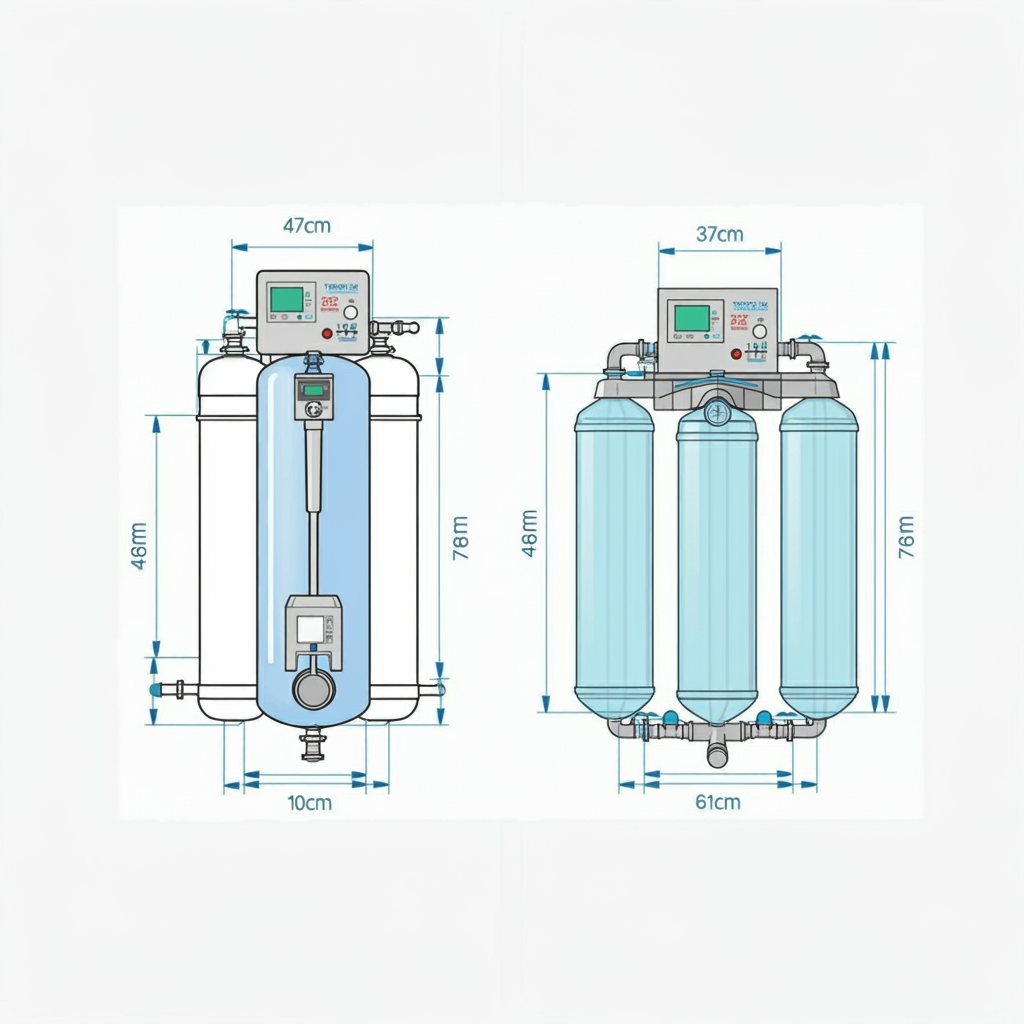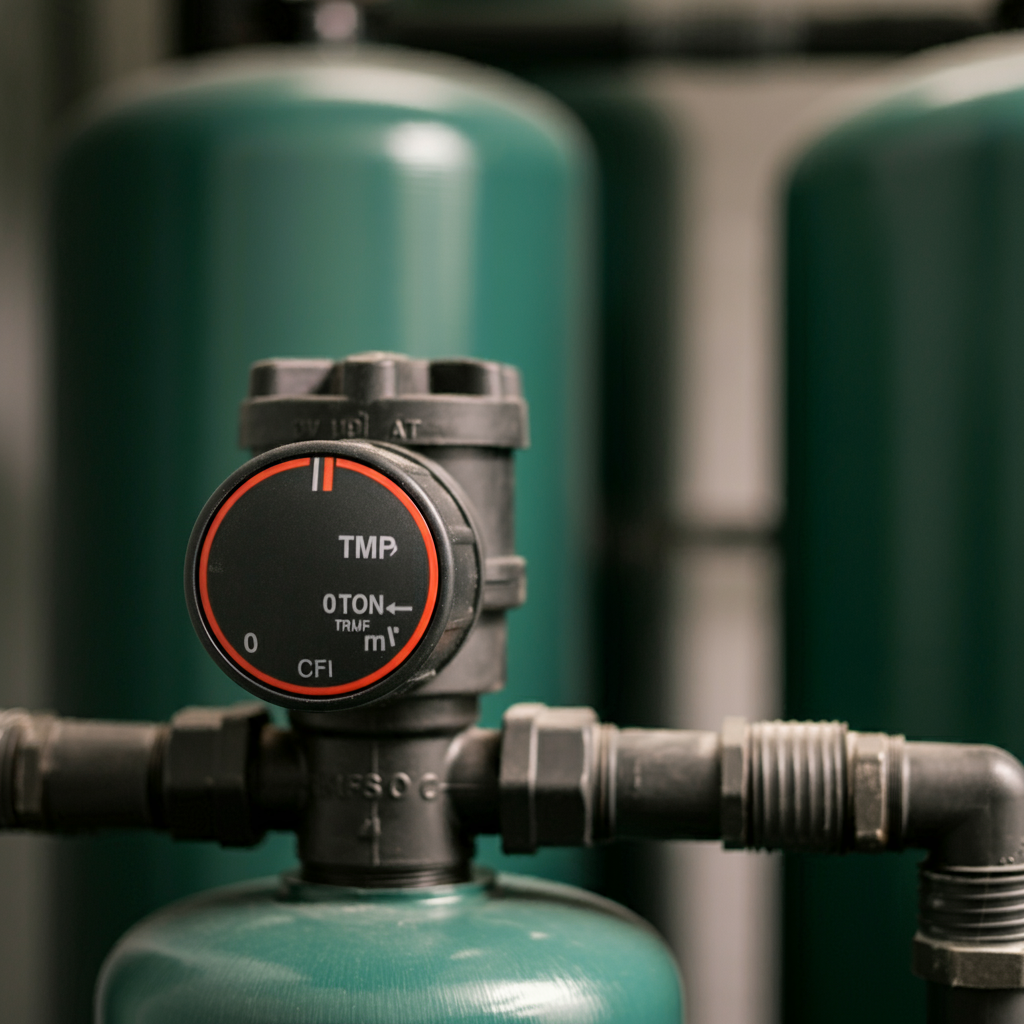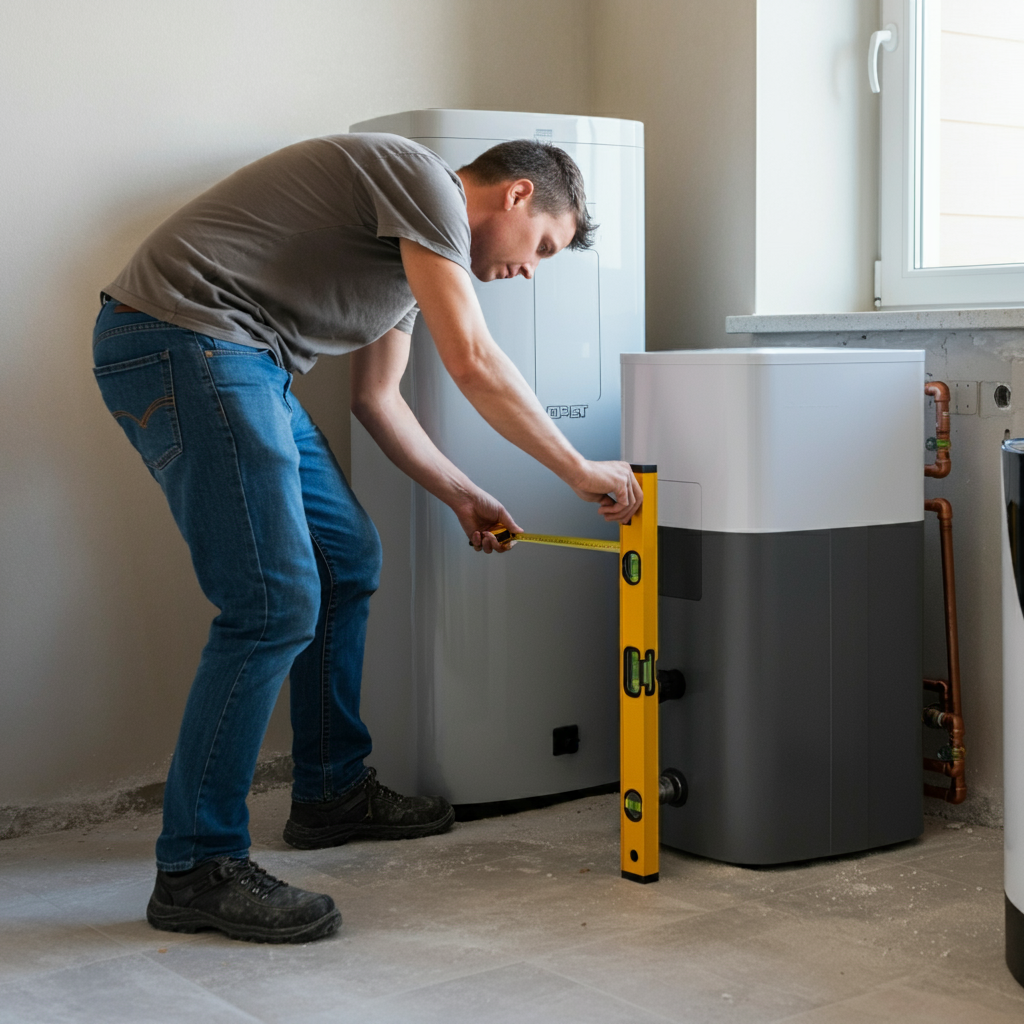Is a dual-tank water softener bigger than a single-tank system? Generally, yes. Dual-tank water softeners, like the popular Kinetico Premier Series, typically have a larger footprint than single-tank models due to the presence of a second resin tank. However, the exact dimensions can vary significantly depending on several factors, including brand, model, and capacity. At WaterSoftenerSizing.com, we understand that choosing the right water softener involves more than just understanding the technology—it’s also about finding a system that fits your space and budget. While dual-tank systems offer continuous soft water and high efficiency, their larger size might not be suitable for every home. Single-tank softeners, such as the GE GXSH40V, are more compact and budget-friendly, making them a good option for smaller households or those with limited installation space. The size of your water softener, whether single or dual-tank, will largely depend on its capacity, measured in grains. This indicates how much hardness the system can remove before needing regeneration. A higher grain capacity, like 48,000 grains, usually translates to a larger unit, regardless of the tank configuration. Other factors, such as tank orientation (vertical or horizontal) and additional features (built-in filters, larger brine tanks), can also influence the overall dimensions.
Direct Size Showdown: Single vs. Dual-Tank Dimensions
The physical dimensions of a water softener are important considerations, especially if you have limited space in your home. Let’s take a closer look at the typical size ranges for both single-tank and dual-tank models:
Average Dimensions of Single-Tank Softeners
Single-tank water softeners are generally more compact, with average dimensions falling within these ranges:
- Height: 36-48 inches
- Width: 10-20 inches
- Depth: 15-25 inches
However, these are just averages, and the actual dimensions can vary based on the softener’s capacity. For instance, a smaller 30,000-grain system designed for a small household will naturally occupy less space than a larger 48,000-grain system intended for a bigger family or a home with very hard water.
Average Dimensions of Dual-Tank Softeners
Dual-tank water softeners, also known as twin-tank systems, are inherently larger due to the presence of a second resin tank. This additional tank allows for continuous soft water delivery even during regeneration cycles, a key advantage over single-tank models. On average, dual-tank softeners have these dimensions:
- Height: 48-60 inches
- Width: 15-30 inches
- Depth: 20-30 inches
As with single-tank systems, the exact size of a dual-tank softener can fluctuate depending on its capacity and specific model.
Visual Comparison Table: Single vs. Dual-Tank Dimensions
| Model | Type | Capacity (Grains) | Height (in) | Width (in) | Depth (in) |
| GE GXSH40V | Single-Tank | 40,000 | 48 | 16 | 21 |
| Fleck 5600SXT | Single-Tank | 48,000 | 54 | 10 | 21 |
| Kinetico Premier Series | Dual-Tank | 48,000 | 52 | 24 | 29 |
| Pelican NaturSoft | Dual-Tank | 32,000 | 44 | 24 | 17 |
Why the Extra Tank?
The second resin tank in a dual-tank system acts as a backup, ensuring uninterrupted soft water production. While one tank is regenerating (cleaning itself), the other tank takes over the softening process. This eliminates the downtime experienced with single-tank softeners during regeneration, providing a constant supply of softened water for your entire home.
Beyond Tanks: Other Factors That Influence Water Softener Size
While the number of tanks is a significant factor, it’s not the sole determinant of a water softener’s size. Several other elements come into play, impacting the overall dimensions and footprint of the unit.
Capacity (Grain Rating): The Primary Size Driver
Regardless of whether you choose a single or dual-tank system, the capacity, measured in grains, is the most influential factor in determining the softener’s size. The grain capacity indicates the amount of hardness minerals the system can remove before needing to regenerate. A higher grain capacity, such as 48,000 grains, is necessary for larger households or homes with exceptionally hard water. These systems will naturally require larger resin and brine tanks to accommodate the increased workload, resulting in a larger overall unit. Conversely, smaller households with moderately hard water might find a 30,000-grain softener sufficient, which would typically be more compact.
Tank Orientation: Vertical vs. Horizontal
Water softener tanks can be oriented either vertically or horizontally. This choice can significantly impact the unit’s dimensions:
- Vertical Tanks: These are taller and narrower, making them a suitable option when floor space is limited but vertical clearance is available.
- Horizontal Tanks: These are shorter and wider, often chosen when there’s ample floor space but limited headroom.
Understanding your available installation space and choosing the appropriate tank orientation can help you optimize the placement of your water softener.
Brand and Model: Unique Designs
Different brands and models of water softeners may have unique designs and features that affect their size. For example, some high-end softeners like the Kinetico Premier Series incorporate advanced technology and additional components, resulting in a slightly larger footprint. It’s essential to check the manufacturer’s specifications for accurate dimensions when comparing specific models.
Additional Features: Integrated Filters and Larger Brine Tanks
Some water softeners come equipped with additional features that can affect their size. For instance, some models include built-in sediment filters to remove dirt and debris from your water. Others might have larger brine tanks to reduce the frequency of salt refills. While these features enhance the softener’s functionality, they can also contribute to a larger overall size.
Does Size Really Matter? Installation Considerations and Space Requirements
When selecting a water softener, it’s crucial to consider not only the size of the unit itself but also the space you have available for installation and the potential plumbing requirements. 
Where Will It Go? Common Installation Locations
Water softeners are typically installed in locations with access to the main water line, a drain, and an electrical outlet. Common installation spots include:
- Basements: Basements offer ample space and easy access to plumbing, making them a popular choice for water softener installation. However, ensure the basement is dry and well-ventilated to prevent moisture damage to the unit.
- Garages: Garages are another convenient option, especially if you have limited space indoors. However, consider temperature fluctuations in your garage, as extreme cold can affect the softener’s performance.
- Utility Rooms: If you have a dedicated utility room, it can be an ideal location for your water softener. However, ensure there’s enough space to access the unit for maintenance and salt refills.
The choice between a vertical or horizontal tank can also influence the ideal location. Vertical tanks are better suited for tight spaces, while horizontal tanks might be preferable if you have ample floor space.
Plumbing Connections: Inlet, Outlet, and Drain
Regardless of the softener’s size or type, all systems require specific plumbing connections:
- Inlet: Connects to your home’s main water line, bringing hard water into the softener for treatment.
- Outlet: Delivers the softened water back into your home’s plumbing system.
- Drain: Allows for the discharge of wastewater during the regeneration process.
Larger water softeners might require additional plumbing modifications or longer pipe runs, which can increase installation complexity and cost.
Professional Installation: When to Call an Expert
While smaller, single-tank softeners can often be installed by homeowners with basic DIY skills, larger dual-tank systems or installations with complex plumbing requirements might necessitate professional assistance. Professional plumbers have the expertise to ensure proper installation, minimizing the risk of leaks or malfunctions. They can also advise on the best location for your softener and make any necessary adjustments to your plumbing system. If you’re unsure about your DIY skills or the specific requirements of your chosen softener, it’s always recommended to consult a qualified plumber for installation.
The Price Tag of Size: Cost Considerations
Understanding the financial implications of different water softener sizes is essential for making an informed purchasing decision. While larger softeners often offer greater capacity and convenience, they also come with a higher price tag.
Dual-Tank Premium: Expect to Pay More
Dual-tank water softeners typically cost more than single-tank models due to several factors:
- Additional Components: The presence of a second resin tank and the control valve mechanism required for alternating between tanks contribute to higher manufacturing costs.
- Advanced Technology: Many dual-tank softeners incorporate sophisticated features like demand-initiated regeneration, which optimizes salt and water usage but can increase the overall price.
- Enhanced Convenience: The continuous soft water supply and reduced maintenance requirements of dual-tank systems often command a premium.
Capacity vs. Cost: Grains Matter More Than Tanks
While dual-tank softeners are generally pricier, the primary cost driver is actually the softener’s capacity, measured in grains. A higher-capacity system, regardless of the number of tanks, will always be more expensive due to the increased amount of resin and the larger tanks required to house it. For example, a 48,000-grain dual-tank softener might cost more than a 32,000-grain single-tank model, even though the latter has only one tank. It’s crucial to prioritize your household’s needs and budget when selecting a softener.
Long-Term Value: Investing in the Right Size
While the initial cost of a larger softener might be higher, it’s important to consider the long-term value. A larger system can handle higher water usage and harder water conditions, potentially lasting longer and requiring less frequent salt refills compared to a smaller model that’s constantly working at maximum capacity. If you have a large household with high water demand or live in an area with extremely hard water, investing in a larger softener, even if it’s a dual-tank model, could prove more cost-effective in the long run. At WaterSoftenerSizing.com, we can help you assess your water usage and hardness levels to determine the ideal softener size for your specific needs and budget. Our goal is to ensure you invest in a system that delivers optimal performance, efficiency, and value over time.
Size Isn’t Everything: Capacity and Efficiency in Water Softening
While size is a practical consideration, it’s essential to remember that the size of a water softener doesn’t directly correlate with its performance. Instead, the capacity and efficiency of the system are far more critical in determining its effectiveness in combating hard water. 
Grain Capacity, Not Size, Dictates Performance
The grain capacity of a water softener, typically ranging from 20,000 to 80,000 grains, is the key indicator of how much hardness it can remove before needing regeneration. This capacity is determined by the amount of resin beads within the tank, which attract and trap the calcium and magnesium ions responsible for hard water. A larger softener with a higher grain capacity, like the Fleck 5600SXT with 48,000 grains, can treat more water before needing regeneration, making it suitable for larger households or areas with very hard water. Conversely, a smaller softener with a lower grain capacity, like the Pelican NaturSoft with 32,000 grains, might be perfectly adequate for a smaller family or a home with moderately hard water.
Efficiency Matters: Salt and Water Savings
The efficiency of a water softener refers to how effectively it utilizes salt and water during the regeneration process. Some smaller softeners, like those using demand-initiated regeneration (DIR) technology, can be surprisingly efficient, consuming less salt and water than larger, less sophisticated models. For example, the Kinetico Premier Series, a dual-tank softener, employs DIR technology to regenerate only when necessary, based on actual water usage. This can lead to significant salt and water savings compared to timer-based softeners, which regenerate on a fixed schedule regardless of water consumption.
WaterSoftenerSizing.com’s Expertise: Finding Your Perfect Fit
At WaterSoftenerSizing.com, we specialize in helping homeowners find the perfect water softener for their unique needs. Our team of experts can assess your water usage, household size, and water hardness levels to accurately calculate the ideal grain capacity and recommend the most suitable softener models. We believe that the right water softener isn’t always the biggest or most expensive one. It’s the one that efficiently and effectively addresses your specific water conditions, providing you with soft, luxurious water while minimizing waste and maximizing value.
Your Perfect Fit: Water Softener Sizes
When it comes to choosing between a single-tank or dual-tank water softener, size is just one piece of a larger puzzle. While dual-tank systems generally require more space due to their additional resin tank, the exact dimensions of both types can vary significantly based on factors like brand, model, and capacity. Remember, the size of your water softener doesn’t necessarily dictate its performance; instead, focus on the grain capacity, which determines the amount of hardness the system can remove before needing regeneration.
Key Takeaways:
- Size Variations: Both single and dual-tank water softeners come in various sizes, with the latter typically requiring more space due to the extra resin tank.
- Capacity Matters Most: The grain capacity of a softener is the key factor in determining how much water it can treat before needing regeneration, making it more important than the number of tanks.
- Efficiency is Key: Smaller softeners equipped with advanced technology like demand-initiated regeneration (DIR) can be just as efficient, if not more so, than larger models.
- Installation Considerations: Think about your available space and plumbing setup when deciding on a softener size and tank orientation.
- Cost-Effectiveness: While dual-tank softeners often come with a higher price tag, they can offer long-term value for households with high water usage or very hard water.
At WaterSoftenerSizing.com, we understand that choosing the right water softener can be a daunting task. That’s why we offer a free water softener sizing calculator to help you determine the ideal capacity for your needs. We also provide personalized recommendations and expert advice to guide you towards the most suitable softener for your home. Ready to take the next step toward softer, healthier water? Visit WaterSoftenerSizing.com today to access our free sizing calculator and explore our range of water softener solutions.

Craig “The Water Guy” Phillips is the founder of Quality Water Treatment (QWT) and creator of SoftPro Water Systems.
With over 30 years of experience, Craig has transformed the water treatment industry through his commitment to honest solutions, innovative technology, and customer education.
Known for rejecting high-pressure sales tactics in favor of a consultative approach, Craig leads a family-owned business that serves thousands of households nationwide.
Craig continues to drive innovation in water treatment while maintaining his mission of “transforming water for the betterment of humanity” through transparent pricing, comprehensive customer support, and genuine expertise.
When not developing new water treatment solutions, Craig creates educational content to help homeowners make informed decisions about their water quality.


